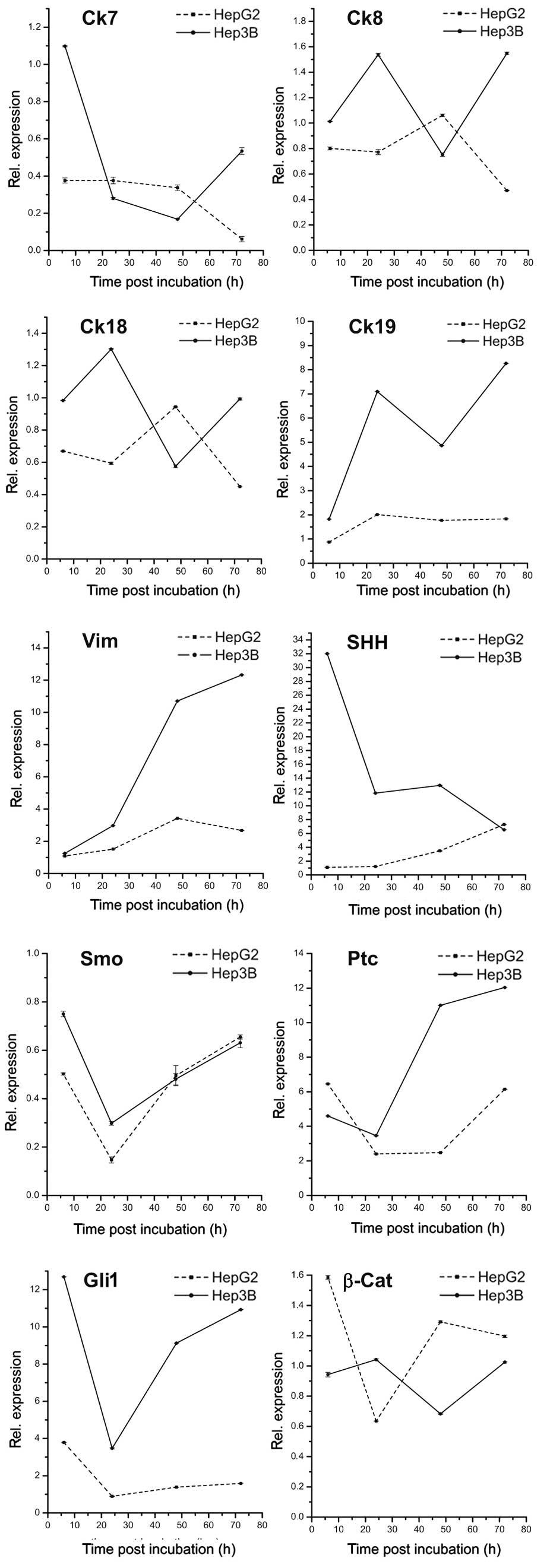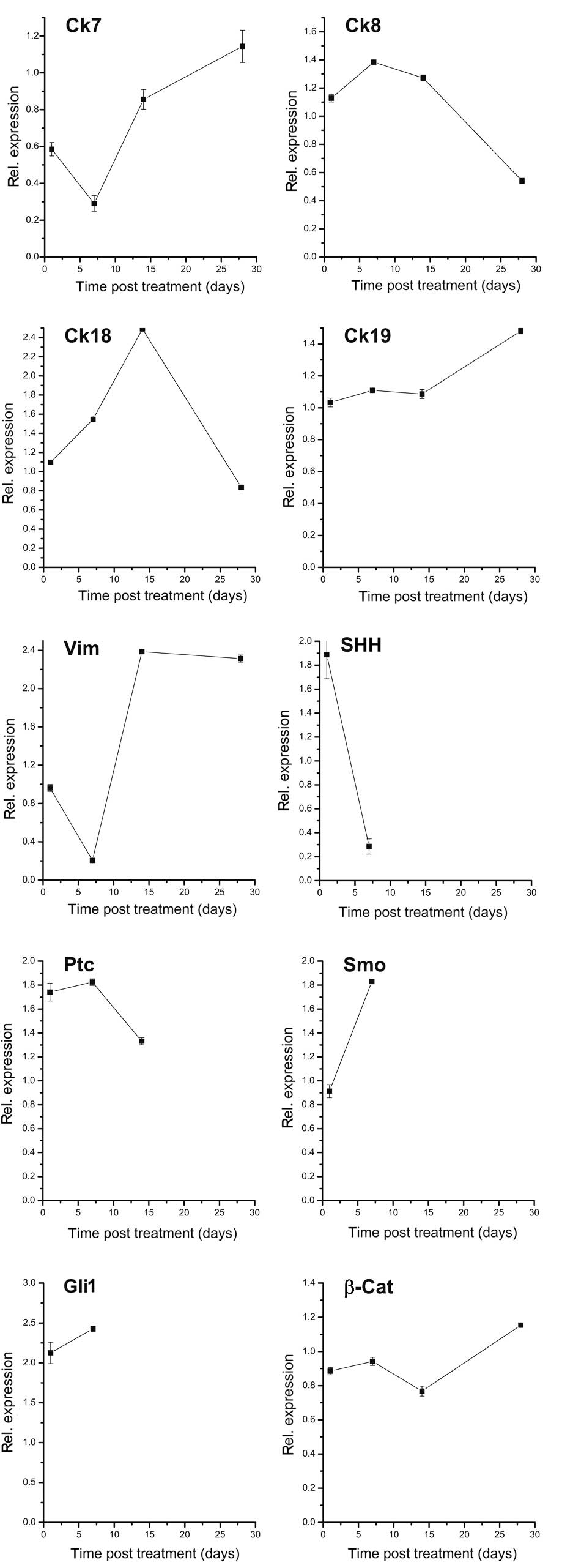|
1
|
Stintzing S, Kemmerling R, Kiesslich T,
Alinger B, Ocker M and Neureiter D: Myelodysplastic syndrome and
histone deacetylase inhibitors: ‘to be or not to be acetylated’? J
Biomed Biotechnol. 2011:2141432011.
|
|
2
|
Miller CP, Singh MM, Rivera-Del Valle N,
Manton CA and Chandra J: Therapeutic strategies to enhance the
anticancer efficacy of histone deacetylase inhibitors. J Biomed
Biotechnol. 2011:5142612011. View Article : Google Scholar : PubMed/NCBI
|
|
3
|
Jana S and Paliwal J: Apoptosis: potential
therapeutic targets for new drug discovery. Curr Med Chem.
14:2369–2379. 2007. View Article : Google Scholar : PubMed/NCBI
|
|
4
|
Schneider-Stock R and Ocker M: Epigenetic
therapy in cancer: molecular background and clinical development of
histone deacetylase and DNA methyltransferase inhibitors. IDrugs.
10:557–561. 2007.
|
|
5
|
Ellis L, Atadja PW and Johnstone RW:
Epigenetics in cancer: targeting chromatin modifications. Mol
Cancer Ther. 8:1409–1420. 2009. View Article : Google Scholar : PubMed/NCBI
|
|
6
|
Ocker M: Deacetylase inhibitors - focus on
non-histone targets and effects. World J Biol Chem. 1:55–61. 2010.
View Article : Google Scholar : PubMed/NCBI
|
|
7
|
Jones PA and Taylor SM: Cellular
differentiation, cytidine analogs and DNA methylation. Cell.
20:85–93. 1980. View Article : Google Scholar : PubMed/NCBI
|
|
8
|
Jones PA, Taylor SM and Wilson V: DNA
modification, differentiation, and transformation. J Exp Zool.
228:287–295. 1983. View Article : Google Scholar : PubMed/NCBI
|
|
9
|
Eguchi G and Kodama R:
Transdifferentiation. Curr Opin Cell Biol. 5:1023–1028. 1993.
View Article : Google Scholar : PubMed/NCBI
|
|
10
|
Neureiter D, Herold C and Ocker M:
Gastrointestinal cancer - only a deregulation of stem cell
differentiation? (Review). Int J Mol Med. 17:483–489.
2006.PubMed/NCBI
|
|
11
|
Gavert N and Ben-Ze’ev A:
Epithelial-mesenchymal transition and the invasive potential of
tumors. Trends Mol Med. 14:199–209. 2008. View Article : Google Scholar : PubMed/NCBI
|
|
12
|
Sabbah M, Emami S, Redeuilh G, Julien S,
Prevost G, Zimber A, Ouelaa R, Bracke M, De Wever O and Gespach C:
Molecular signature and therapeutic perspective of the
epithelial-to-mesenchymal transitions in epithelial cancers. Drug
Resist Updat. 11:123–151. 2008. View Article : Google Scholar : PubMed/NCBI
|
|
13
|
Hanahan D and Weinberg RA: The hallmarks
of cancer. Cell. 100:57–70. 2000. View Article : Google Scholar
|
|
14
|
Hanahan D and Weinberg RA: Hallmarks of
cancer: the next generation. Cell. 144:646–674. 2011. View Article : Google Scholar : PubMed/NCBI
|
|
15
|
Jemal A, Bray F, Center MM, Ferlay J, Ward
E and Forman D: Global cancer statistics. CA Cancer J Clin.
61:69–90. 2011. View Article : Google Scholar
|
|
16
|
Greten TF, Korangy F, Manns MP and Malek
NP: Molecular therapy for the treatment of hepatocellular
carcinoma. Br J Cancer. 100:19–23. 2009. View Article : Google Scholar : PubMed/NCBI
|
|
17
|
Choi SS and Diehl AM:
Epithelial-to-mesenchymal transitions in the liver. Hepatology.
50:2007–2013. 2009. View Article : Google Scholar
|
|
18
|
Rountree CB, Mishra L and Willenbring H:
Stem cells in liver diseases and cancer: recent advances on the
path to new therapies. Hepatology. 55:298–306. 2012. View Article : Google Scholar : PubMed/NCBI
|
|
19
|
McDonald OG, Wu H, Timp W, Doi A and
Feinberg AP: Genome - scale epigenetic reprogramming during
epithelial-to-mesenchymal transition. Nat Struct Mol Biol.
18:867–874. 2011. View Article : Google Scholar : PubMed/NCBI
|
|
20
|
Marquardt JU, Factor VM and Thorgeirsson
SS: Epigenetic regulation of cancer stem cells in liver cancer:
current concepts and clinical implications. J Hepatol. 53:568–577.
2010. View Article : Google Scholar : PubMed/NCBI
|
|
21
|
Jabari S, Meissnitzer M, Quint K, Gahr S,
Wissniowski T, Hahn EG, Neureiter D and Ocker M: Cellular
plasticity of trans- and dedifferentiation markers in human
hepatoma cells in vitro and in vivo. Int J Oncol. 35:69–80.
2009.PubMed/NCBI
|
|
22
|
Kiesslich T, Alinger B, Wolkersdorfer GW,
Ocker M, Neureiter D and Berr F: Active Wnt signalling is
associated with low differentiation and high proliferation in human
biliary tract cancer in vitro and in vivo and is sensitive to
pharmacological inhibition. Int J Oncol. 36:49–58. 2010.PubMed/NCBI
|
|
23
|
Neureiter D, Zopf S, Dimmler A, Stintzing
S, Hahn EG, Kirchner T, Herold C and Ocker M: Different
capabilities of morphological pattern formation and its association
with the expression of differentiation markers in a xenograft model
of human pancreatic cancer cell lines. Pancreatology. 5:387–397.
2005. View Article : Google Scholar
|
|
24
|
Neureiter D, Zopf S, Leu T, Dietze O,
Hauser-Kronberger C, Hahn EG, Herold C and Ocker M: Apoptosis,
proliferation and differentiation patterns are influenced by
Zebularine and SAHA in pancreatic cancer models. Scand J
Gastroenterol. 42:103–116. 2007. View Article : Google Scholar : PubMed/NCBI
|
|
25
|
Maiso P, Carvajal-Vergara X, Ocio EM,
Lopez-Perez R, Mateo G, Gutierrez N, Atadja P, Pandiella A and San
Miguel JF: The histone deacetylase inhibitor LBH589 is a potent
antimyeloma agent that overcomes drug resistance. Cancer Res.
66:5781–5789. 2006. View Article : Google Scholar : PubMed/NCBI
|
|
26
|
Atadja P: Development of the pan-DAC
inhibitor panobinostat (LBH589): successes and challenges. Cancer
Lett. 280:233–241. 2009. View Article : Google Scholar : PubMed/NCBI
|
|
27
|
Di Fazio P, Schneider-Stock R, Neureiter
D, Okamoto K, Wissniowski T, Gahr S, Quint K, Meissnitzer M,
Alinger B, Montalbano R, Sass G, Hohenstein B, Hahn EG and Ocker M:
The pan-deacetylase inhibitor panobinostat inhibits growth of
hepatocellular carcinoma models by alternative pathways of
apoptosis. Cellular Oncology. 32:285–300. 2010.PubMed/NCBI
|
|
28
|
Kemmerling R, Stintzing S, Muhlmann J,
Dietze O and Neureiter D: Primary testicular lymphoma: A strictly
homogeneous hematological disease? Oncol Rep. 23:1261–1267.
2010.PubMed/NCBI
|
|
29
|
Alison MR, Lim SM and Nicholson LJ: Cancer
stem cells: problems for therapy? J Pathol. 223:147–161. 2011.
View Article : Google Scholar : PubMed/NCBI
|
|
30
|
Ailles LE and Weissman IL: Cancer stem
cells in solid tumors. Curr Opin Biotechnol. 18:460–466. 2007.
View Article : Google Scholar : PubMed/NCBI
|
|
31
|
Schrader J, Gordon-Walker TT, Aucott RL,
van Deemter M, Quaas A, Walsh S, Benten D, Forbes SJ, Wells RG and
Iredale JP: Matrix stiffness modulates proliferation,
chemotherapeutic response, and dormancy in hepatocellular carcinoma
cells. Hepatology. 53:1192–1205. 2011. View Article : Google Scholar
|
|
32
|
Na DC, Lee JE, Yoo JE, Oh BK, Choi GH and
Park YN: Invasion and EMT-associated genes are up-regulated in B
viral hepatocellular carcinoma with high expression of CD133-human
and cell culture study. Exp Mol Pathol. 90:66–73. 2011. View Article : Google Scholar : PubMed/NCBI
|
|
33
|
van ’t Veer LJ, Dai H, van de Vijver MJ,
He YD, Hart AA, Mao M, Peterse HL, van der KK, Marton MJ, Witteveen
AT, Schreiber GJ, Kerkhoven RM, Roberts C, Linsley PS, Bernards R
and Friend SH: Gene expression profiling predicts clinical outcome
of breast cancer. Nature. 415:530–536. 2002.PubMed/NCBI
|
|
34
|
Perou CM, Sorlie T, Eisen MB, van de RM,
Jeffrey SS, Rees CA, Pollack JR, Ross DT, Johnsen H, Akslen LA,
Fluge O, Pergamenschikov A, Williams C, Zhu SX, Lonning PE,
Borresen-Dale AL, Brown PO and Botstein D: Molecular portraits of
human breast tumours. Nature. 406:747–752. 2000. View Article : Google Scholar : PubMed/NCBI
|
|
35
|
Wittekind C and Tannapfel A: Regression
grading of colorectal carcinoma after preoperative
radiochemotherapy. An inventory Pathologe. 24:61–65.
2003.PubMed/NCBI
|
|
36
|
Lachenmayer A, Toffanin S, Cabellos L,
Alsinet C, Hoshida Y, Villanueva A, Minguez B, Tsai HW, Ward SC,
Thung S, Friedman SL and Llovet JM: Combination therapy for
hepatocellular carcinoma: additive preclinical efficacy of the HDAC
inhibitor panobinostat with sorafenib. J Hepatol. 56:1343–1350.
2012. View Article : Google Scholar : PubMed/NCBI
|
|
37
|
Zitvogel L, Kepp O and Kroemer G: Immune
parameters affecting the efficacy of chemotherapeutic regimens. Nat
Rev Clin Oncol. 8:151–160. 2011. View Article : Google Scholar : PubMed/NCBI
|
|
38
|
Todaro M, Francipane MG, Medema JP and
Stassi G: Colon cancer stem cells: promise of targeted therapy.
Gastroenterology. 138:2151–2162. 2010. View Article : Google Scholar : PubMed/NCBI
|
|
39
|
Diaz DM, Hernandez AA, Pereira GS,
Jaramillo S, Virizuela Echaburu JA and Gonzalez-Campora RJ:
Gastrointestinal stromal tumors: morphological, immunohistochemical
and molecular changes associated with kinase inhibitor therapy.
Pathol Oncol Res. 17:455–461. 2011. View Article : Google Scholar
|
|
40
|
Lee J, Im YH, Lee SH, Cho EY, Choi YL, Ko
YH, Kim JH, Nam SJ, Kim HJ, Ahn JS, Park YS, Lim HY, Han BK and
Yang JH: Evaluation of ER and Ki-67 proliferation index as
prognostic factors for survival following neoadjuvant chemotherapy
with doxorubicin/docetaxel for locally advanced breast cancer.
Cancer Chemother Pharmacol. 61:569–577. 2008. View Article : Google Scholar
|
|
41
|
Moll R, Divo M and Langbein L: The human
keratins: biology and pathology. Histochem Cell Biol. 129:705–733.
2008. View Article : Google Scholar : PubMed/NCBI
|
|
42
|
Goteri G, Olivieri A, Ranaldi R, Lucesole
M, Filosa A, Capretti R, Pieramici T, Leoni P, Rubini C, Fabris G
and Lo ML: Bone marrow histopathological and molecular changes of
small B-cell lymphomas after rituximab therapy: comparison with
clinical response and patients outcome. Int J Immunopathol
Pharmacol. 19:421–431. 2006.
|
|
43
|
Ryningen A, Stapnes C and Bruserud O:
Clonogenic acute myelogenous leukemia cells are heterogeneous with
regard to regulation of differentiation and effect of epigenetic
pharmacological targeting. Leuk Res. 31:1303–1313. 2007. View Article : Google Scholar
|
|
44
|
Urtasun R, Latasa MU, Demartis MI, Balzani
S, Goni S, Garcia-Irigoyen O, Elizalde M, Azcona M, Pascale RM, Feo
F, Bioulac-Sage P, Balabaud C, Muntane J, Prieto J, Berasain C and
Avila MA: Connective tissue growth factor autocriny in human
hepatocellular carcinoma: oncogenic role and regulation by
epidermal growth factor receptor/yes-associated protein-mediated
activation. Hepatology. 54:2149–2158. 2011. View Article : Google Scholar
|
|
45
|
Hoshida Y, Toffanin S, Lachenmayer A,
Villanueva A, Minguez B and Llovet JM: Molecular classification and
novel targets in hepatocellular carcinoma: recent advancements.
Semin Liver Dis. 30:35–51. 2010. View Article : Google Scholar : PubMed/NCBI
|
|
46
|
Kiesslich T, Neureiter D, Alinger B,
Jansky GL, Berlanda J, Mkrtchyan V, Ocker M, Plaetzer K and Berr F:
Uptake and phototoxicity of meso-tetrahydroxyphenyl chlorine are
highly variable in human biliary tract cancer cell lines and
correlate with markers of differentiation and proliferation.
Photochem Photobiol Sci. 9:734–743. 2010. View Article : Google Scholar : PubMed/NCBI
|
|
47
|
Wachter J, Neureiter D, Alinger B, Pichler
M, Fuereder J, Oberdanner C, Di Fazio P, Ocker M, Berr F and
Kiesslich T: Influence of five potential anticancer drugs on wnt
pathway and cell survival in human biliary tract cancer cells. Int
J Biol Sci. 8:15–29. 2012. View Article : Google Scholar : PubMed/NCBI
|
|
48
|
Kiesslich T, Berr F, Alinger B, Kemmerling
R, Pichler M, Ocker M and Neureiter D: Current status of
therapeutic Targeting of developmental signalling pathways in
oncology. Curr Pharm Biotechnol. 13:2184–2220. 2012. View Article : Google Scholar : PubMed/NCBI
|
|
49
|
Finn RS, Dering J, Ginther C, Wilson CA,
Glaspy P, Tchekmedyian N and Slamon DJ: Dasatinib, an orally active
small molecule inhibitor of both the src and abl kinases,
selectively inhibits growth of basal-type/‘triple-negative’ breast
cancer cell lines growing in vitro. Breast Cancer Res Treat.
105:319–326. 2007.PubMed/NCBI
|

















